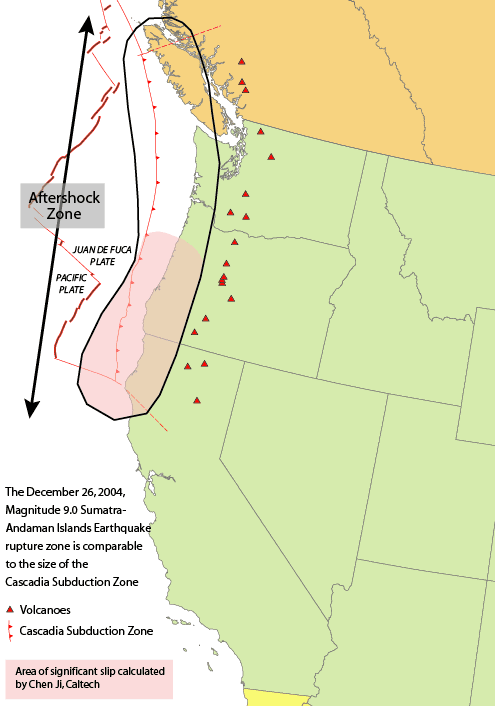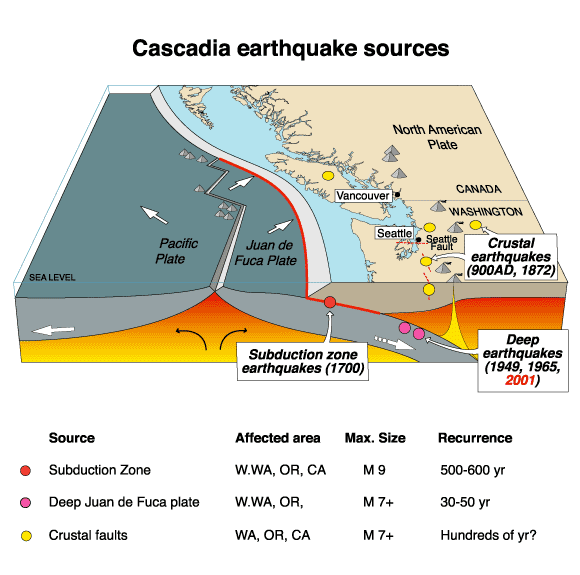Skip to comments.
Earthquake in Chile -- a complicated fracture
Helmholtz Association of German Research Centres ^
| Mar 9, 2010
| Unknown
Posted on 03/09/2010 7:10:39 AM PST by decimon
A jumping rupture process
The extremely strong earthquake in Chile on 27 February this year was a complicated rupture process, as scientists from the GFZ German Research Centre for Geosciences found out. Quakes with such magnitude virtually penetrate the entire Earth's crust. After closer analysis of the seismic waves radiated by this earthquake during the first 134 seconds after start of the rupture, the researchers came to the conclusion that only the region around the actual epicentre was active during the first minutes. In the second minute the active zone moved north towards Santiago. After that the region south of Concepción became active for a short time. This rupturing trend agrees well with the distribution of the aftershocks during the following three days, as observed by the GEOFON-measuring network of the GFZ up to 03.03.2010.
In the year 1960, the strongest earthquake measured at all to date, with a magnitude of M=9.5, had its origin at Valdivia, south of the region affected now. "The quake of 27 February connects directly to the rupture process of Valdivia", explains Professor Jochen Zschau, Director of the Section "Earthquake Risk and Early Warning" at the GFZ. "With this, one of the last two seismic gaps along the west coast of South America might now be closed. With the exception of one last section, found in North Chile, the entire earth crust before the west coast of South America has been ruptured within the last 150 years."
The underlying plate tectonic procedure is such that the Nazca-Plate as part of the Pacific Ocean Floor moves eastwards with approximately seventy millimetres per year, collides with South America and thereby pushes under the continent. The hereby developing earthquakes belong to the strongest world-wide. In the course of about one century, the Earth's ruptures completely in a number of strong quakes from Patagonia in the South to Panama in the North. Even Darwin reported, in his diary, of the strong earthquake in Concepción on 20 February 1835 and the resulting Tsunami.
In order to examine the aftershock activity in the now fractured seismic gap, scientists from the GFZ are travelling to Chile on March 13, 2010 where, together with the Chilean Seismological Service, they will set-up a seismological-geodetic network in the area of Concepción-Santiago. Partners from Germany (IFM Geomar, Kiel; Free University of Berlin) and from abroad (Institut de Physique du Globe, Paris; University of Liverpool; United States Geological Survey; IRIS) are also taking part in this measuring campaign. The mission will last about three months. The results, one expects, will be able to provide an insight into the mechanisms of the fracture in the Earth's crust. This activity is financed on the German side by the GFZ.
Scientists from the GFZ have been examining the collision of the Nazca plate and the South American continent since 1994. As a result of numerous expeditions and measuring campaigns in this area this Potsdam Helmholtz Centre avails of the probably the most dense data record on such a subduction zone. "Within the framework of the DFG Priority Programme "Deformation processes in the Andes", and with the Geotechnology Project TIPTEQ we have just been able to collect a unique data record for the southern part of the Andes" says Professor Onno Oncken, Director of the Department Geodynamics and Geomaterials at the GFZ, and leader of these studies. The current quake puts us in the position to precisely compare the tectonics before and afterwards, a unique situation both internationally and in Earth science.
Currently, the GFZ operates a so-called Plate Boundary Observatory PBO in the north of Chile, exactly in the last remaining seismic gap in Chile. This observatory will be handed over to Chilean colleagues by the Chairman of the Board of the GFZ, Professor Reinhard Huettl, within the framework of the cooperation with the Earthquake Service of Chile during a festive event on 15 March.
###
The integrated field experiment is accompanied by the new Berlin-Brandenburg research platform Geo.X, which took up its work on 03 March 2010.
Illustrations in printable form can be found under: http://www.gfz-potsdam.de/portal/gfz/Public+Relations/M40-Bildarchiv/Bildergalerie+Chile-Erdbeben
TOPICS: History; Science
KEYWORDS: catastrophism
1
posted on
03/09/2010 7:10:39 AM PST
by
decimon
To: SunkenCiv
Holy jumpin’ rupture ping.
2
posted on
03/09/2010 7:11:16 AM PST
by
decimon
To: decimon
I read that the entire city of Concepcion was moved 10 feet.
3
posted on
03/09/2010 7:27:22 AM PST
by
SWAMPSNIPER
(THE SECOND AMENDMENT, A MATTER OF FACT,NOT A MATTER OF OPINION)
To: decimon
maybe it’ll reveal oil/gas like it did in haiti. We could use a decent south american oil exporter besides Colombia.
4
posted on
03/09/2010 7:28:26 AM PST
by
utherdoul
To: decimon
A big rupture that size can place MASSIVE stress on other huge formations. If one of them rips, we could get a cascade effect: very large earthquakes occuring with increasing frequency.
Scary stuff...
5
posted on
03/09/2010 9:13:01 AM PST
by
piytar
(Ammo is hard to find! Bought some lately? Please share where at www.ammo-finder.com)
To: piytar
You were saying ...
A big rupture that size can place MASSIVE stress on other huge formations. If one of them rips, we could get a cascade effect: very large earthquakes occuring with increasing frequency.
In the Pacific Northwest, the Cascadia Subduction Zone can produce earthquakes of the size of 9.0 to 10.0 ... and one is due for that area, too... (according to the pattern of the previous ones... ooops...).


AND..., this is nothing new for our present time, as it's been going on like this for hundreds of years, even thousands of years... so it's a very regular type of cycle.
6
posted on
03/09/2010 12:47:15 PM PST
by
Star Traveler
(Remember to keep the Messiah of Israel in the One-World Government that we look forward to coming)
To: decimon; gleeaikin; 75thOVI; aimhigh; Alice in Wonderland; AndrewC; aragorn; aristotleman; ...
In the year 1960, the strongest earthquake measured at all to date, with a magnitude of M=9.5, had its origin at Valdivia, south of the region affected now. "The quake of 27 February connects directly to the rupture process of Valdivia", explains Professor Jochen Zschau, Director of the Section "Earthquake Risk and Early Warning" at the GFZ. "With this, one of the last two seismic gaps along the west coast of South America might now be closed. With the exception of one last section, found in North Chile, the entire earth crust before the west coast of South America has been ruptured within the last 150 years."
Ow!
Thanks decimon.
7
posted on
03/09/2010 3:30:07 PM PST
by
SunkenCiv
(Freedom is Priceless.)
To: SunkenCiv
*kof*
:where am i: (she asks, plaintively)
8
posted on
03/09/2010 3:51:58 PM PST
by
Monkey Face
(I wear a yellow ribbon for my Army Hero grandson and the warrior goddess of the Coasties)
To: Monkey Face
Listening to Carl Perkins?
9
posted on
03/09/2010 4:59:56 PM PST
by
SunkenCiv
(Freedom is Priceless.)
To: Monkey Face
Whoops, that s/b Jerry Lee Lewis...
10
posted on
03/09/2010 5:01:31 PM PST
by
SunkenCiv
(Freedom is Priceless.)
To: SunkenCiv; All
I know there was a very large EQ in Assam, probably in the 1950’s that was supposed to have increased the height of Everest. I had thought that was the biggest. Anyone know for sure?
Disclaimer:
Opinions posted on Free Republic are those of the individual
posters and do not necessarily represent the opinion of Free Republic or its
management. All materials posted herein are protected by copyright law and the
exemption for fair use of copyrighted works.
FreeRepublic.com is powered by software copyright 2000-2008 John Robinson


